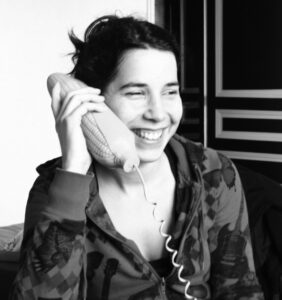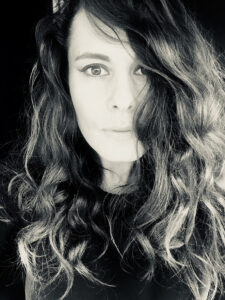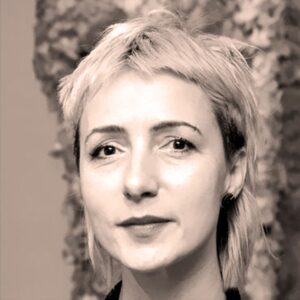Anja Tončić
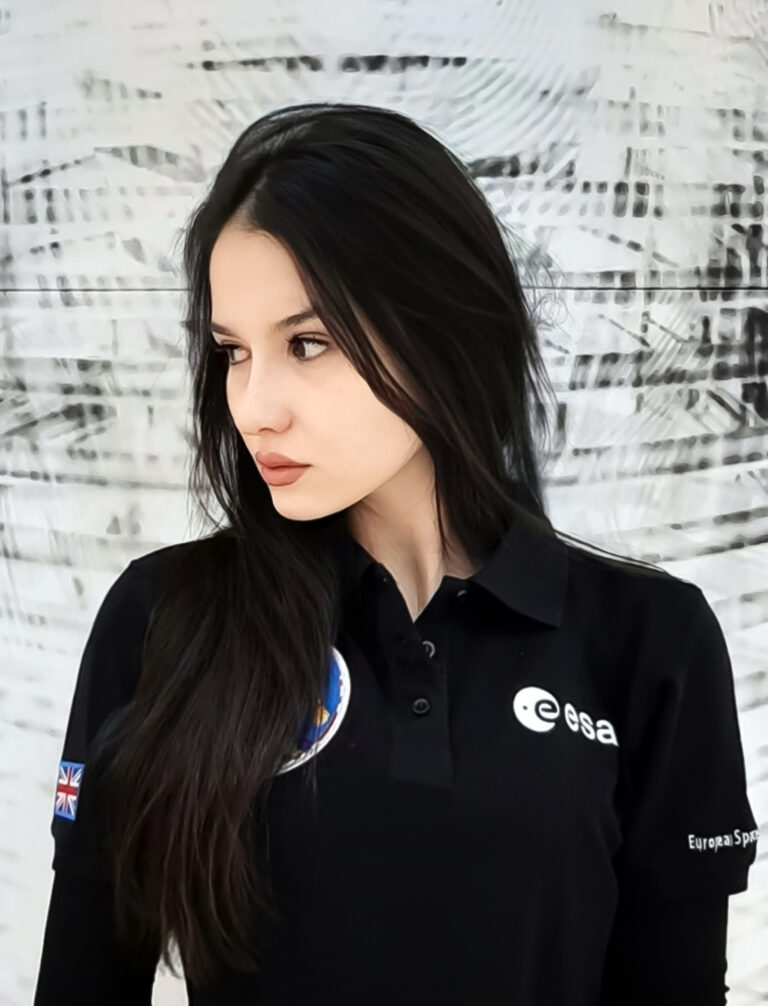
– (1996, Belgrade, Serbia) completed her undergraduate studies in 2018, and her master’s studies in 2019 at the Faculty of Fine Arts in Belgrade, at the department of painting. Since 2013, she has participated in over 85 group and 12 solo exhibition projects in Serbia and abroad. Since 2019, she has been a representative of the Rector’s Council of the University of Arts in Belgrade. Since 2018, she has been actively collaborating with the X VITAMIN gallery in Belgrade, as well as with the ITP in Vienna (Institute for Theoretical Physics – Technische Universität Wien) as an analytical consultant for visual experiments. As of 2020, she is a registered independent artist of the Association of Fine Artists of Serbia (ULUS). She works at the intersections of visual arts, statistical physics and acoustics. Her work is focused on the processes of cybernetics, oscillation, refraction, and the concept of (cyclic) generativity, using media such as drawing, installations, painting, sound, graphic techniques, objects, photography, spatial dynamics, as well as applied science in artistic relations. She currently lives and works in Belgrade and Vienna.
Although seemingly diametrically opposed fields, art and science are different ends of the same domains of inventiveness. Each of them stands for an iterative process that requires enormous focus, productivity and perseverance, both directing recipients to reach for the truth and to question by merging their own experience with what they perceive, while embracing reality with constant generative wonder and admiration. During the three years I spent as a researcher and analytical assistant at the ITP (Institute for Theoretical Physics – Technische Universität) in Vienna, due to my initial education in the field of natural sciences, I became aware of how poorly scientists communicate with the public, which inevitably determined the course I chose in order to expand my experimental practice in applied physics into the realms of artistic expression.
I started to focus on the scientific storytelling point of view. In my work, I was prevented from verbally communicating analytical results to those who do not have the scientific qualification, and therefore I want to make science accessible to the society in a way that invites people to explore the limits of cognition of the phenomena that surround us, through the technical virtualities of painting, drawings, installations, objects, graphic techniques, analog photographs… 123
I believe that it is precisely art that can provide access to the further progress of science and basic scientific literacy, because most of the time we are collectively in an echo chamber. The fight against misinformation is extremely important in order to empower people from different professions and levels of education to take control of their actions and their potential. That also means fighting against a particularly harmful phenomenon: the invisibility of women in science. Not only do they make up barely 30% of STEM researchers worldwide, but they are also too often marginalised – the work of women scientists and their successes and results are often directly attributed to the male mentors or groups without their mention. It is tragic that systemic gender-based inequalities are persistently repeated in contemporary trends, so defiance and constant striving for equal access is the key reason why I translate scientific information into accessible messages through artistic skills.
Since my childhood was spent under the devastating effect of the sanctions during the 1990s, after the breakup of Yugoslavia, I quickly became aware of the necessity of action through a form of expression that can be engaged in an indirect as well as a direct, explicit way. Also, the current situation where we have a very unstable base after the global pandemic and irrational aggression and xenophobia in all parts of the world proves that any form of art that deals with the consequences and risks of misunderstanding technical and scientific achievements and social movements is increasingly important and necessary. Therefore, my works are introspective in nature, even though they are based on data visualization4. I develop my art towards a methodological and discursive expansion, especially of the medium of drawing. Although seemingly anachronistic as a procedure, drawing directly engages the artist’s ability to establish and control the relationships between observation, evaluation, and materialization56. I use technical flaws as source material for the further hand-generative expression, as opposed to the conventional glitch art where the glitch is an aestheticized front layer. In my works, I combine temporal data sets in which three-dimensional spatial points (longitude, latitude, altitude) carry timestamps, revealing the complex virtual movement of the traces of their own disappearance. With the analysis of frequencies and acoustics of sound with variable delay lines as a result of refraction and reactivity, the visual outcome cannot be captured by any software articulations or be predetermined through video manipulations7.
The accessibility of artistic expressions is important to me, so I am more and more attracted to the idea of art in public space through media that allow the artist to get closer to those who are not members of the artistic community themselves. The issue of increasingly emphasised museum and gallery elitism and political propaganda is a seismic, but fruitful area of alteration of forms of personal and collective reflection, constantly returning to the practice and negation of the superficial layer of representation. In this I am aided by the cyclical loss of stability as an improvisation that I find in the expansion of the approach, trying to treat the sphere of the exact as a vast field of variability and the subject of everyone’s necessary individual experience. My works have been described as filled with intimacy, although that is unexpected at first glance. It is an intimacy in the forms of silent functioning on a micro-level, but always inherent to the protagonists of the catalysis of particles and reactions89.
It is an intimacy that belongs to everyone who does or does not want to identify with any of the categories, independent from any single narrative, description or spectacles of materialistic affectations – that kind of intimacy that does not allow the marginalisation of people and their lives, but makes them all connected through processes that existed before us and will remain after us, without attempts for simulation.
The text was written in collaboration with Mirjana Dragosavljević (2022).
1Illustration: Anja Tončić, Selection of analog photographs (Polaroids) created during the optical research program at the Institute for Theoretical Physics – Technische Universität in Vienna, 2019 - 2022.2Illustration: Anja Tončić, DE MOTU I, graphite, charcoal and chalk on paper, a reproduction of the drawing of the Mach's Principle, installed in space, 100 x 1200 cm, 2018 - 19.
3Illustration: Anja Tončić, Dirac sea series, 20 filament reliefs based on the theoretical model of a vacuum as a sea of particles with negative energy, PLA carbon fibres, each 50 x 50 cm, 2018 - 20.
4Illustration: Anja Tončić, 1/f = 1/v + 1/u, Drawing installations on convex mirrors, wooden boxes (diptych), each 140 x 40 x 80 cm, 2021. The creation of these multidimensional drawings are not in accord with the classic definition of stereopsis, which presupposes that the perception of depth and three-dimensional structure is possible only with information visible from only one perspective.
5Illustration: Anja Tončić, Nanoflakes series. A series of 50 drawings on paper, each measuring 50 x 50 cm, 2018-2022. Drawing recreation of the experiment of the nuclear destruction reaction and radioactive radiation of Alpha particles.
6Illustration: Anja Tončić, Euclid's Orchard, rotating image / object in space, 190 x 60 cm, 2020. The object was created using the principle of Specular Holography - a method for creating a display by controlling the virtual movement on a two-dimensional surface; unlike wavefront holograms, the principle of operation is geometrical optics only.
7Illustration: Anja Tončić, Tachyon I, II and III, paintings on canvas, acrylic markers and oil paints, each 180 x 120 cm, 2020 - 2022
8Illustration: Anja Tončić, Foucault Cage, quartz sand, pendulum, drawing on glass, box with mirror coating, 150 x 40 x 90 cm, 2022.
9Illustration: Anja Tončić, FAR - FIELD, diffractive variable spatial installation, 2019.
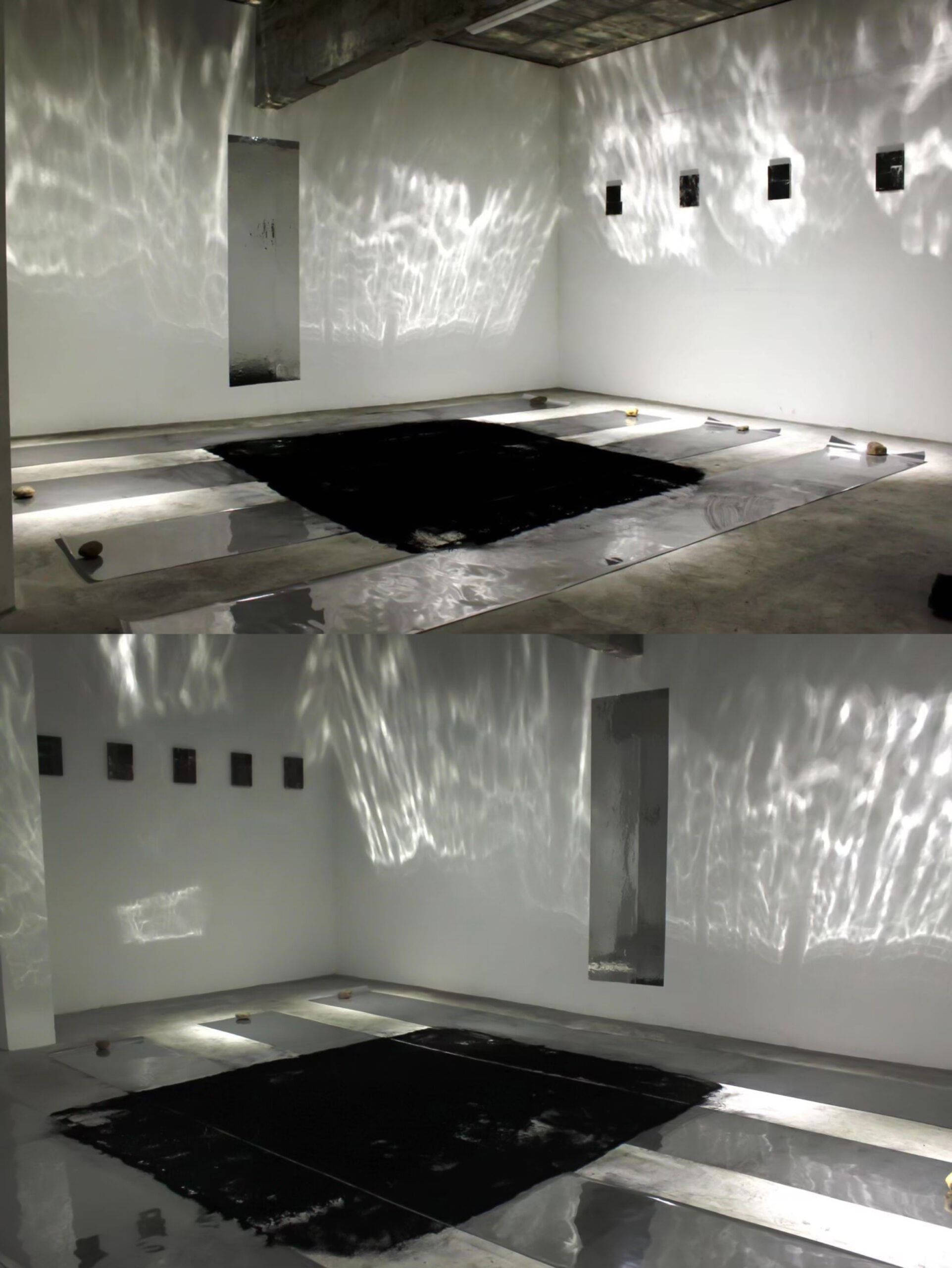
– (1996, Beograd, Srbija) diplomirala je na osnovnim akademskim studijama 2018. godine, kao ina Master studijama 2019. godine na Fakultetu likovnih umetnosti u Beogradu, na odseku slikarstvo. Od 2013. učesnica je na preko 85 grupnik i 12 samostalnih izlagačkih projekata u zemlji i inostranstvu. Od 2019. godine je predstavnica Saveta Rektorata Univerziteta umetnosti u Beogradu.
Od 2018. godine aktivno sarađuje sa galerijom X vitamin u Beogradu, kao i sa ITP-om u Beču (Institute for Theoretical Physics – Technische Universitat Wien) kao analitička savetnica za vizuelne eksperimente. Od 2020. godine je u statusu samostalnog umetnika Udruženja likovnih umetnika Srbije (ULUS). Radi na presecima vizuelnih umetnosti, statističke fizike i akustike. Njen rad se fokusira na procese kibernetike, oscilacija, refrakcija, i pojma (ciklične) generativnosti, koristeći medije kao što su crtež, instalacije, slikarstvo, zvuk, grafičke tehnike, objekti, fotografija, prostorna dinamika, kao i primenjena nauka u likovnim odnosima. Trenutno živi i radi u Beogradu i Beču.
Iako naizgled dijametralno suprotne oblasti, umetnost i nauka su različiti krajevi istih domena inventivnosti. Svaki od njih je iterativni proces koji zahteva ogroman fokus, produktivnost i istrajnost, oba nudeći recipijentima da posežu za istinom i pitanjima stapajući sopstveno iskustvo u ono što percipiraju, uz prihvatanje stvarnosti sa stalnim generativnim čuđenjem i divljenjem. Tokom provedene 3 godine kao istraživač i analitički asistent na ITP-u (Institut za teorijsku fiziku – Technische Universitat) u Beču, usled mog inicijalnog obrazovanja u domenu prirodnih nauka, postala sam svesna koliko loše naučnici komuniciraju sa javnošću, što je nužno predodredilo moj odabran smer da svoju eksperimentalnu praksu primenjene fizike proširim u domete umetničkog izraza.
Počela sam da se fokusiram na gledište pripovedanja nauke. U svom poslu sam bila sprečena da verbalno prenosim analitičke rezultate onima koji nemaju naučnu stručnu spremu i zbog toga želim da nauku učinim dostupnom u društvo na način koji poziva ljude u istraživanje granica spoznaje pojava oko nas, putem tehničkih virtuelnosti slikarstrva, crteža, instalacija, objekata, grafičkih tehnika, analognih fotografija…123 Smatram da upravo umetnost može da obezbedi pristup daljem progresu nauke i bazične naučne pismenosti, jer smo većinu vremena kolektivno u eho komori. Borba protiv dezinformacija je od izuzetne važnosti kako bi se ljudi različitih profesija i nivoa obrazovanja osnažili da preuzmu kontrolu nad svojim postupcima i svojim mogućnostima. To takođe znači i borbu protiv posebno štetne pojave: nevidljivosti žena u nauci. One ne samo da čine jedva 30% STEM istraživača širom sveta, već su takođe prečesto gurnute na marginu – rad naučnica i njihovi uspesi i rezultati često se direktno pripisuju muškim mentorima ili grupama bez pomena. Tragično je da se i u savremenim tendencijama uporno ponavljaju sistemski rodno zasnovane nejednakosti, te je prkos i stalna težnja za jednakim pristupom ključan povod zašto putem umetničkih veština prevodim naučne informacije u svima dostupne poruke.
Od detinjstva provedenog u razornom efektu sankcija 90-ih godina neposredno nakon raspada Jugoslavije, veoma brzo mi se oformila svest o nužnosti delovanja kroz formu izraza koji može biti angažovan na indirektan koliko i direktan, eksplicitan način. Takođe, trenutna situacija veoma nestabilne osnove nakon globalne pandemije i iracionalne agresije i ksenofobije u svim delovima sveta dokazuje da je svaki oblik umetnosti koji se bavi posledicama i rizicima nerazumevanja tehničkih i naučnih postignuća i društvenih kretanja sve važniji i potrebniji. Stoga, moji radovi su po prirodi introspektivni, iako se zasnivaju na vizualizaciji podataka4. Svoju umetnost razvijam ka metodološkoj i diskurzivnoj ekspanziji posebno crtačkog medija. Iako naizgled anahrono kao postupak, crtež direktno angažuje umetnikovu sposobnost da uspostavi i kontroliše odnose između posmatranja, evaluacije i materijalizacije56. Koristim tehničke nedostatke kao izvorni materijal za dalje ručno-generativni iskaz, za razliku od konvencionalne glitch umetnosti u kojoj je greška estetizovani sloj fronta. U svojim radovima kombinujem temporalne skupove podataka u kojima trodimenzionalne prostorne tačke (longitude, latitude, altitude) nose vremenske oznake, otkrivajući složeno virtuelno kretanje tragova sopstvenog iščezavanja. Uz analizu frekvencija i akustike zvuka sa promenljivim linijama kašnjenja (delay lines) kao proizvod prelamanja i reaktivnosti, vizuelni rezultat se ne može uhvatiti bilo kakvim softverskim artikulacijama ili predeterminisati kroz video manipulacije7.
Bitna mi je dostupnost umetničkih iskaza, tako da sve više bivam privučena ideji umetnosti u javnom prostoru putem medija koji omogućavaju umetniku da se približi onima koji nisu samo deo umetničke zajednice. Pitanje sve češće naglašenog muzejskog i galerijskog elitizma i političke propagande je trusno, ali plodno područje alteracije vidova lične i kolektivne refleksije, uz stalno vraćanje praksi i negaciji površnog sloja reprezentacije. U tome mi pomaže cikličnost gubitka stabilnosti kao improvizacija koju pronalazim u ekspanziji pristupa nastojeći da tretiram sferu egzaktnog kao ogromno polje varijabilnosti i predmet svačijeg neophodnog individualnog iskustva. Moji radovi su opisivani kao ispunjeni intimnošću, iako je ona na prvi pogled neočekivana. To je intimnost u oblicima tihog funkcionisanja na mikro-nivou, ali uvek svojstvena ljudima koji su protagonisti katalizacije čestica i reakcija89.
To je intima koja pripada svima koji žele ili ne žele da se identifikuju sa bilo kakvim kategorijama, nezavisna od jednog narativa, deskripcije ili spektakla materijalnih usiljenosti – ona intima koja ne dozvoljava da marginalizuje ljude i njihove živote, već ih sve čini povezanim kroz procese koje su bili pre nas i koje će nakon nas ostati, bez pokušaja simulacije.
Tekst je napisan u saradnji sa Mirjanom Dragosavljević (2022).
1Ilustracija: Anja Tončić, Izbor analognih fotografija (polaroida) nastalih tokom programa optičkih istraživanja na Institutu za teorijsku fiziku - Technischen Universitat u Beču, 2019 - 22.2Ilustracija: Anja Tončić, DE MOTU I, grafit, ugalj i kreda na papiru, reprodukcija u crtežu Mahovog principa instalirana u prostoru, 100 x 1200 cm, 2018 - 19.
3Ilustracija: Anja Tončić, Dirac sea series, 20 filamentnih reljefa po teorijskom modelu vakuuma kao mora čestica sa negativnom energijom, PLA karbonska vlakna, svaki po 50 x 50 cm, 2018 - 20.
4Ilustracija: Anja Tončić, 1/f = 1/v + 1/u, Instalacije-crteži na konveksnim ogledalima, drvene kutije, (diptih) svaki po 140 x 40 x 80 cm, 2021. Nastanak ovih višedimenzionalnih crteža se ne slažu sa klasičnim Stereopsisom, koji predviđa da je percepcija dubine i trodimenzionalne strukture moguće jedino sa informacijama vidljivim samo iz jedne perspektive.
5Ilustracija: Anja Tončić, Nanoflakes series. Serija od 50 crteža na papiru, dimenzija po 50 x 50cm, 2018 – 22. Crtačko rekreiranje eksperimenta reakcije neklearnog razaranja i radioaktivnog zračenja Alpha čestica.
6Ilustracija: Anja Tončić, Euclid's orchard, rotirajuća slika / objekat u prostoru, 190 x 60 cm, 2020. Objekat kreiran primenom principa Spekularne holografije - metodom za kreiranje prikaza kontrolisanjem virtuelnog kretanja na dvodimenzionalnoj površini, za razliku od holograma talasnog fronta, princip rada je samo geometrijska optika.
7Ilustracija: Anja Tončić, Tachyon I, II i III, slike na platnu, akrilni markeri i uljane boje, svaka po 180 x 120 cm, 2020 – 22.
8Ilustracija: Anja Tončić, Foucault cage, kvarcni pesak, klatna, crtež na staklu, kutija sa premazom ogledala, 150 x 40 x 90 cm, 2022.
9Ilustracija: Anja Tončić, FAR - FIELD, difrakciona promenjiva prostorna instalacija, 2019.

